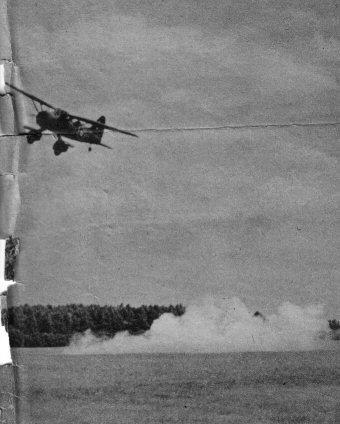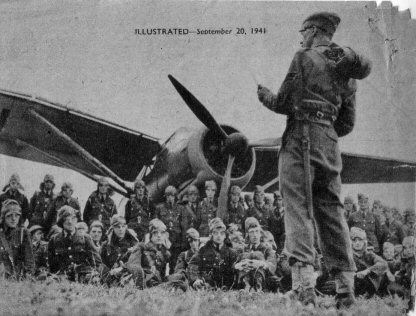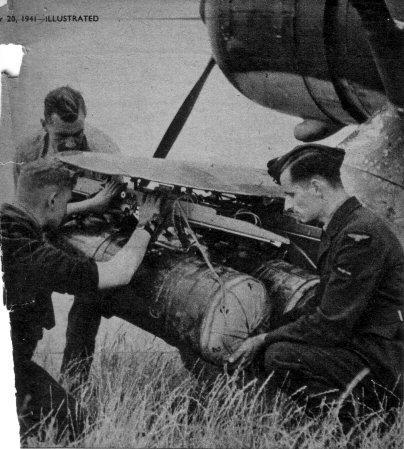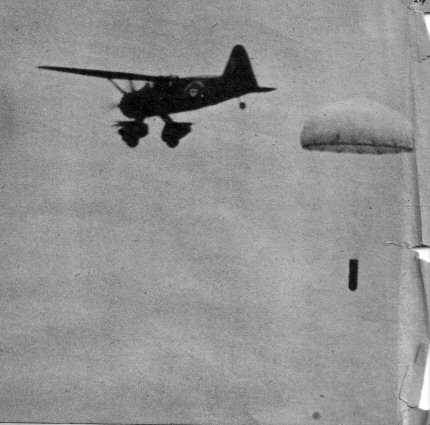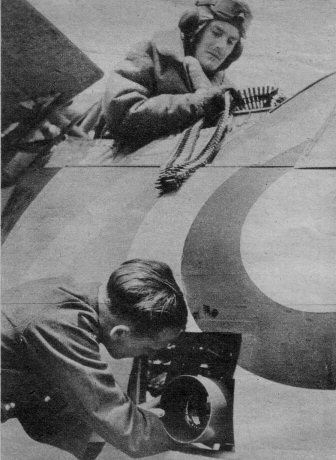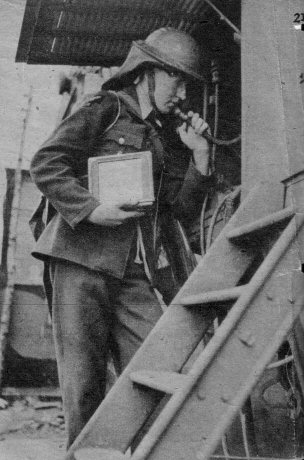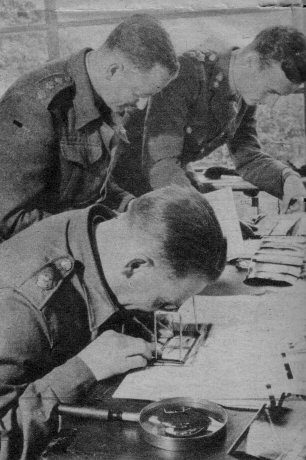Illustrated newspaper article - September 20, 1941
This article was among Edward Packe's papers. However, it had been carelessly cut out of the newspaper, and words along one side of the columns had been cut off. I have tried to reconstruct the missing words to complete the article.The Army's Wings
are in the news
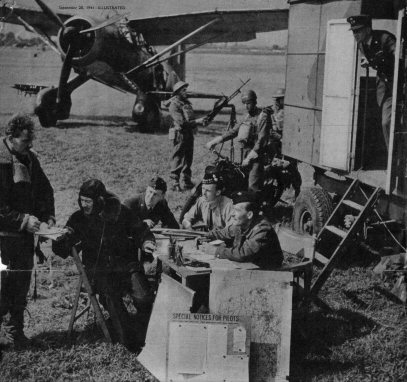 The mobile office - you might almost call it a "war room" - with every Army Co-operation squadron. A "Lysander" has just landed (in background) and the pilot is making his report. The A.L.O. (Army Liaison Officer) is sitting at his desk (extreme right). A dispatch rider stands by. In the office is a wireless transmitter.
The mobile office - you might almost call it a "war room" - with every Army Co-operation squadron. A "Lysander" has just landed (in background) and the pilot is making his report. The A.L.O. (Army Liaison Officer) is sitting at his desk (extreme right). A dispatch rider stands by. In the office is a wireless transmitter.
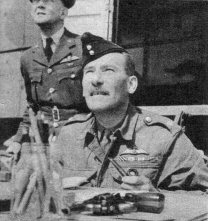 Edward Packe is the A.L.O. in both photographs. In fact, he said that this photo was posed. In reality, pilots were seen alone by him, immediately after they landed, in a special room.
Edward Packe is the A.L.O. in both photographs. In fact, he said that this photo was posed. In reality, pilots were seen alone by him, immediately after they landed, in a special room.
Left, the A.L.O. awaits the arrival of another "Lysander".
But it is a healthy and promising youngster. And we are going to hear a lot more of it when that day comes on which we shall get to grips again with the German Army.
For one of the outstanding lessons of this war has been that aerial "close support" is absolutely essential to the success of land operations. The Germans have taught us that, and a smarting and bitter lesson it has been.
But we have learned well. The spectacular victories in Libya and Africa, when for the first time land and air arms worked together as one, is a proof of that. And a final recognition of the point has been the formation, last December, of the Army Co-operation Command of the R.A.F. under Air Marshall Sir Arthur Barratt, who commanded the R.A.F. in France during the blitzkrieg.
All the squadrons of Army Co-ops. are under the operational control of the Army Command with which they work - though for training and everything else they come under the R.A.F. Most of the flying personnel have volunteered for this branch of the R.A.F. So have certain other key men in the command, such as the army liaison officers.
Pilots are drawn from the R.A.F. and from the Army. The proportions from each Service are roughly fifty-fifty. All pilots wear R.A.F. uniform. The A.L.O.s wear their khaki. Training of pilots, because they must be specialists, is rather more lengthy than in any other command of the R.A.F.
First of all the pilot passes "through the mill" of flying training like the fighter or bomber pilot. After he has got his wings the Training and Development Group of Army Co-ops. takes him over, and he embarks on a long and arduous technical course. This group has units all over Britain and Northern Ireland, usually placed in rather isolated parts of the country. Included among these units is the organization responsible for the training of British parachute troops. Other units supply practice for anti-aircraft gunners. They provide aircraft and pilots for towing "sleeve targets" at which the gunners blaze away with live ammunition. They also operate the "Queen Bees" - pilotless radio-controlled aircraft - which are also used for target practice by the Army's A.A. gunners.
The Air Artillery Observation Officer - Service descendant of the man who wore the half-wing on his tunic in the last war is the most important person in Army Co-ops. He receives expert training with certain observation methods and with devices, radio and otherwise, which for speed and precision of direction would make his 1918 predecessors green with envy - or just blankly disbelieving.
Other units carry out experiments to perfect the radio location system, which as you know, is our most effective defence against the night bomber.
article contd.
article contd.
The Army Co-ops. pilot trains with lessons in tactical reconnaissance work he would have to over the field of battle itself, such as the estimation of numbers and direction of movement of tanks, troops, artillery and so on.
In this war, with its vastly improved A.A. gunnery and with swift fighter aircraft, reconnaissance machines cannot make leisurely low-level inspection of battle terrains. So the pilot must be able to make split-second observations with no errors. No use for instance to report a line of mobile kitchens as a line of tanks.
And he must be able to assess at a glance the nature of terrain from varying angles and under different conditions. The commander may want to know whether he can get his men across a certain river. Can it can be forded, what are the approaches like, and the banks for temporary bridge building? - and a host of similar questions.
Then comes training in strategical reconnaissance - work which goes on well behind enemy lines. The pilot must be able to decipher railroad movement and site direction of supplies and reinforcement concentrations.
Besides these larger affairs he gets training and practice in message dropping, "spotting" for artillery, supplies dropping, wireless operation, bombing from high and low levels and "ground strafing" of enemy troops. He has know how to look after himself and his aircraft in the air; combat and avoiding tactics against enemy aircraft.
During this training he gets plenty of practice with real troops and transport. A known number of soldiers and transport is disposed in a certain area and proceeding in a given direction and it is up to the Army Co-ops. pilot to find them and report the previously known facts accurately to the instructors.
Classroom work and actual flying practice are supplemented by ingenious teaching devices.
The army liaison officers who are seconded to each Army Co-operation squadron also go through a special course. Their job in action is, with their special knowledge of land warfare and the information they have received from army headquarters, to "brief" the pilots on the general situation before they depart on reconnaissance, and to give them specific instructions as to what information is required.
When the pilots return with their mission accomplished the A.L.O.s have to think how to interpret photographs and verbal reports, and make correct decisions as to what items must be reported to the Army right away.
The Westland "Lysander" is the maid-of-all-work to the Army Co-operation Command. It has been specially modified for army reconnaissance and air support work in France last year and in this year's Middle East campaigns. It has a top speed of 225 m.p.h., but can be take off loaded at a speed as low as [?]
The ability To fly at such low speeds is an important point with reconnaissance aircraft. So are short run "take-offs" since aircraft working with the Army Co-ops. do not always operate from large aerodromes. The Lysander can get off the ground in less than 200 yards. The wheel "spats" hold machine-guns for attack and defence. The short stub wings above the spats can carry bombs, message and supply containers, flares and spare fuel. The design gives the pilot excellent visibility - about 160 degrees on either side. But newer types may possibly come into operation with the command.
The essence of every Army Co-operation squadron is its complete mobility. It can pack its traps and depart for any part of the country at very short notice. It is entirely self-contained with a command defence organization and includes its own maintenance, equipment stores, photographic, wireless, first-aid and transport sections.
Because of the threat of invasion everyone of the officers and men has been trained in the use of small arms - rifle, pistol, bayonet fighting, and the operation of four types of machine gun and the standard model of anti-tank gun.
Whether they wear Air Force blue as RAF men, or the khaki of the A.L.O.s all of them are now part of a single] command of which they are justly proud. Its special traditions are still in the process of creation, but the knowledge, experience and skill of the command's personnel has advanced day by day since those tragic days of sixteen months ago.
When the time comes for their testing in the final conflict with our dire enemy, they will not fail. I believe, in fact, that when that day comes, they will be able to teach the enemy something about a phase of of war of which he thought he knew everything.
CARL OLSSON
